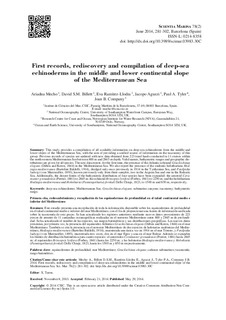First records, rediscovery and compilation of deep-sea echinoderms in the middle and lower continental slope of the Mediterranean Sea
Mecho, Ariadna; Billett, David S.M.; Ramirez Llodra, Eva; Aguzzi, Jacopo; Tyler, Paul A.; Company, Joan B.
Journal article, Peer reviewed
Permanent lenke
http://hdl.handle.net/11250/227091Utgivelsesdato
2014Metadata
Vis full innførselSamlinger
- Publikasjoner fra Cristin - NIVA [2149]
- Scientific publications [1172]
Originalversjon
Mecho, A. et al. (2014). First records, rediscovery and compilation of deep-sea echinoderms in the middle and lower continental slope of the Mediterranean Sea. Scientia Marina, 78(2): 281-302 10.3989/scimar.03983.30CSammendrag
This study provides a compilation of all available information on deep-sea echinoderms from the middle and lower slopes of the Mediterranean Sea, with the aim of providing a unified source of information on the taxonomy of this group. Previous records of species are updated with new data obtained from 223 trawl hauls conducted in 11 cruises within the Northwestern Mediterranean Sea between 800 m and 2845 m depth. Valid names, bathymetric ranges and geographic distributions are given for all species. The new data report, for the first time, the presence of the Atlantic echinoid Gracilechinus elegans (Düben and Koren, 1844) in the Mediterranean Sea. We also report the presence of the endemic holothurians Hedingia mediterranea (Bartolini Baldelli, 1914), dredged only once previously in 1914 in the Tyrrhenian Sea, and Penilpidia ludwigi (von Marenzeller, 1893), known previously only from three samples, two in the Aegean Sea and one in the Balearic Sea. Additionally, the deeper limits of the bathymetric distribution of four species have been expanded: the asteroid Ceramaster grenadensis (Perrier, 1881) to 2845 m; the echinoid Brissopsis lyrifera (Forbes, 1841) to 2250 m; and the holothurians Hedingia mediterranea and Holothuria (Panningothuria) forskali Delle Chiaje, 1823, to 1500 m and 850 m, respectively.

